Last Updated on July 19, 2020
It is no secret that high fiber fruits benefit your digestive system, boost your metabolism and provide a long satiety effect.
There is evidence that people who eat foods high in dietary fiber per serving find it generally easier to keep their shape and/or lose pounds. At the same time, they protect themselves against lifestyle diseases.
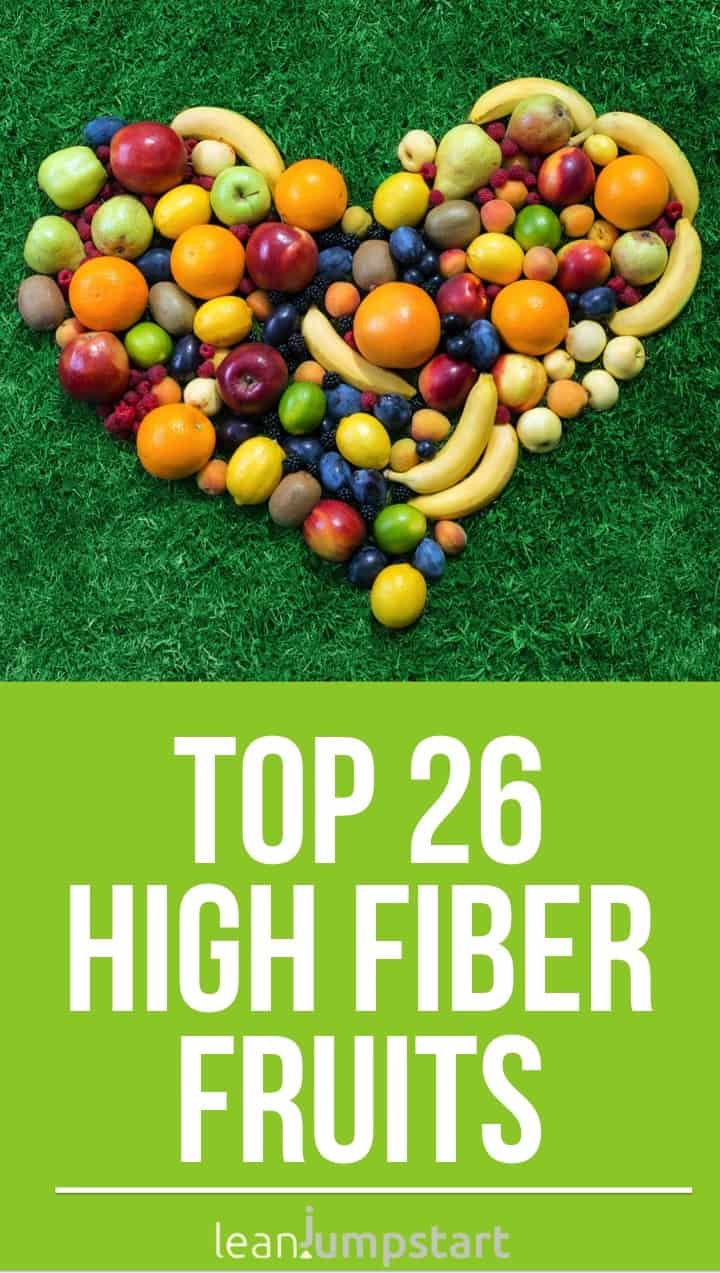
The easiest way to increase your roughage intake is to eat plenty of fruits, vegetables, and whole grain products.
Soluble versus insoluble fiber in fruits
Most fruits have unique properties due to their content of insoluble and soluble fibers. The most benefits for your health provide the soluble substances which belong to the group of prebiotics. These act as gelling agents and the colon bacteria use them as a food source.
Insoluble fibers (the typical roughage) usually cannot be fermented in the large intestine and do not dissolve in water. They support the digestive system as natural “bulk-forming agents”. This helps you get a more regular, softer and healthy bowel movement.
Do you know what fruits are high in fiber?
As a general overview, I’ve put together the top 9 into a chart which you can share or pin for later use. A detailed table showing all top 26 vitamin bombs you’ll find versus the end of this blog post.
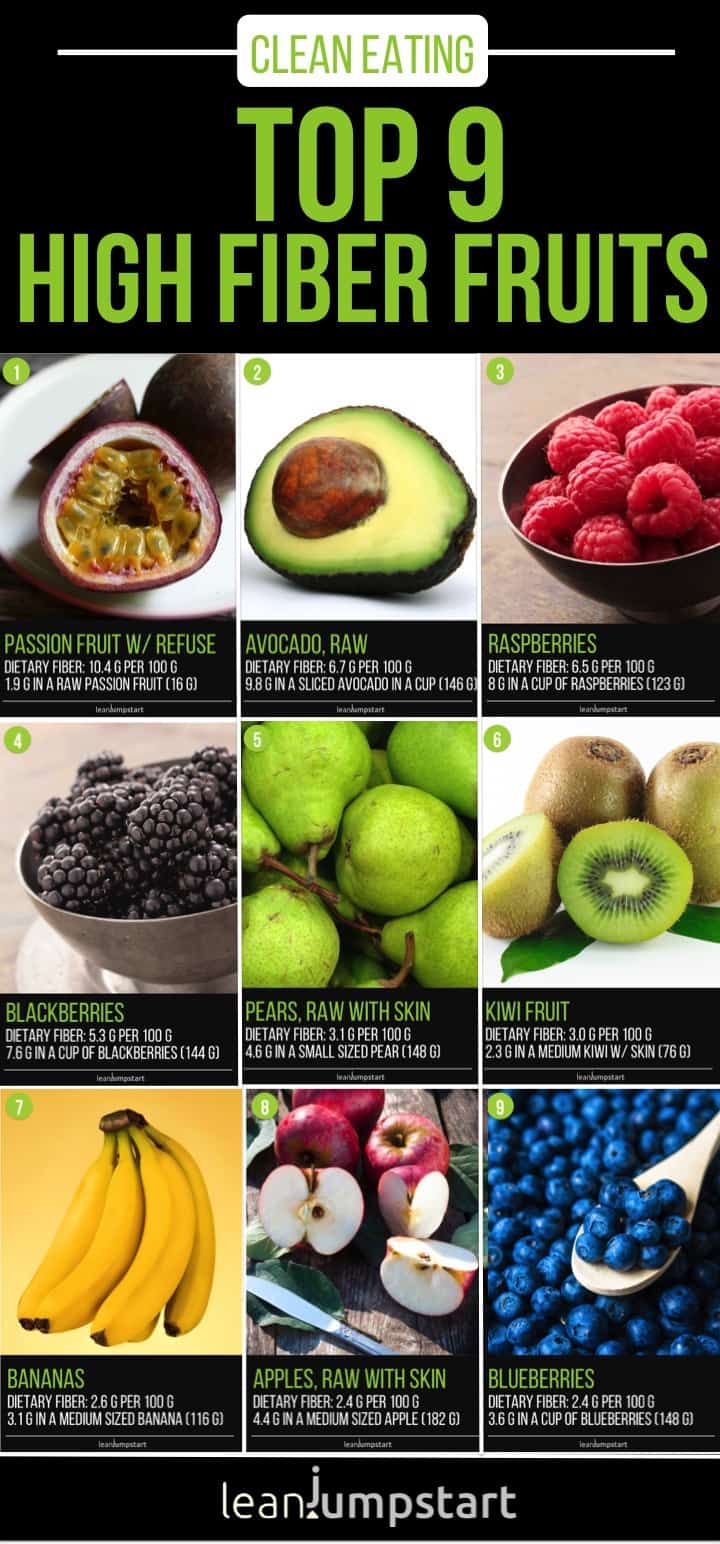
Let’s take a closer look at some specific data of fruit types you can easily buy, e.g. at Aldi. All following database comes from the USD’s National Nutrient Database for Standard Reference.
1. Passionfruit (10.4%)
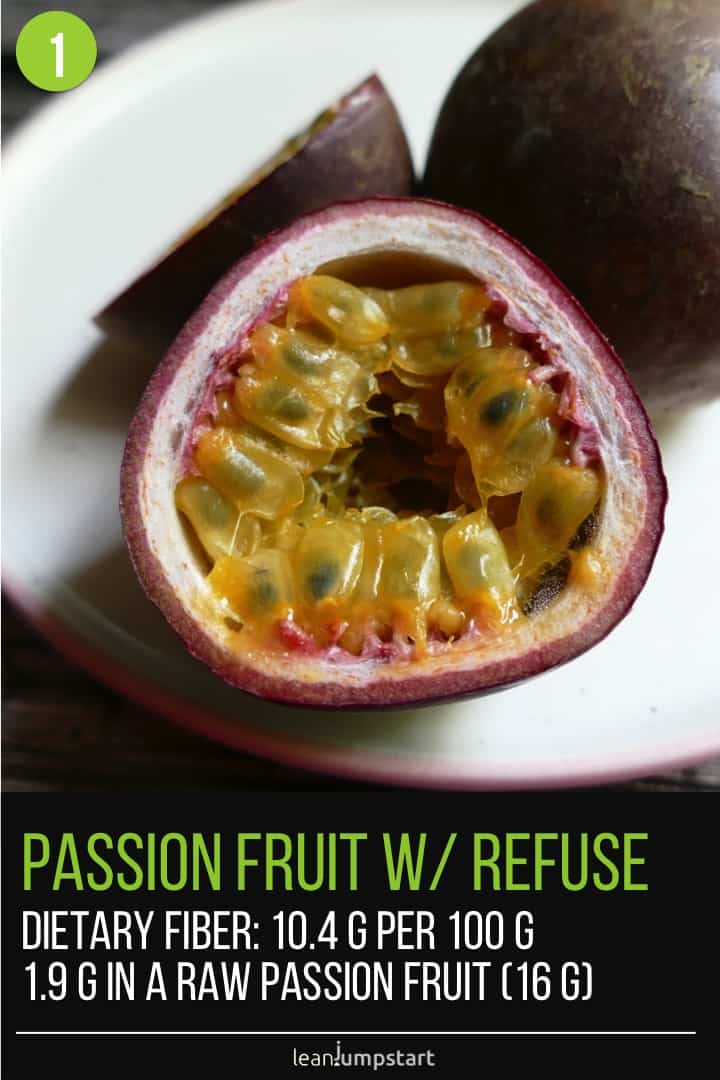
These exotic fruits don’t typically count to the clean eating snacks you commonly eat. But hopefully, you will rethink your snacking habits after reading this article.
Also known as granadilla, passion fruit wins the fiber race and surpasses even dried fruits. Pleasantly sweet and sour, it is brimming with many plant-derived nutrients. By the way, you can buy fairly traded passion fruits at Aldi (at least here in Germany).
Fiber content: 10.4 g per 100 g (1), or 1.9 g in a purple, raw passion fruit – without refuse (16 g).
2. Avocado, raw (6.7%)
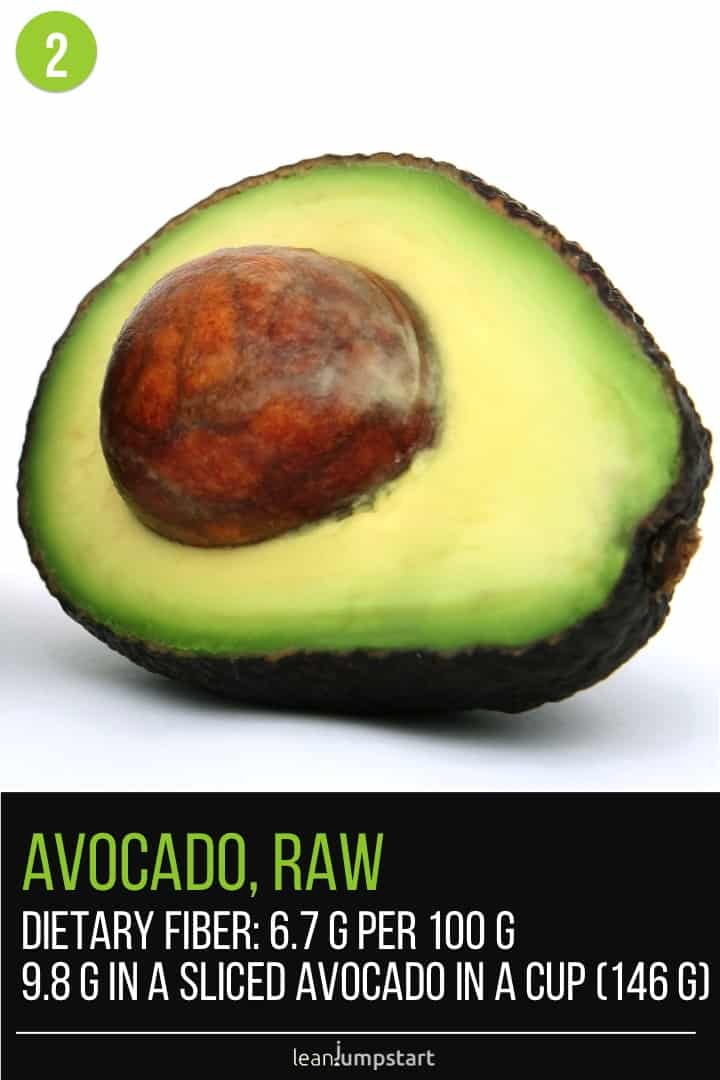
You may ask if an avocado is a fruit or a vegetable? The avocado is technically a fruit, although some might be inclined to call it a vegetable.
Avocados contain both, natural gelling and stool bulking agents. The fiber in avocado aids in lowering cholesterol by maintaining digestive function and help your body prevent sugar peaks after meals.
This fat rich food contains also many healthy Omega-3 fatty acids. These fatty acids are also known to help lower cholesterol levels and prevent heart disease. But that’s not all. These nutritional powerhouses are high in protein too compared to other fruits.
Fiber content: 6.7 g per 100 g (2), or 9.8 g in a medium sized avocado – in a cup, sliced, (146 g).
3. Raspberries, raw (6.5%)
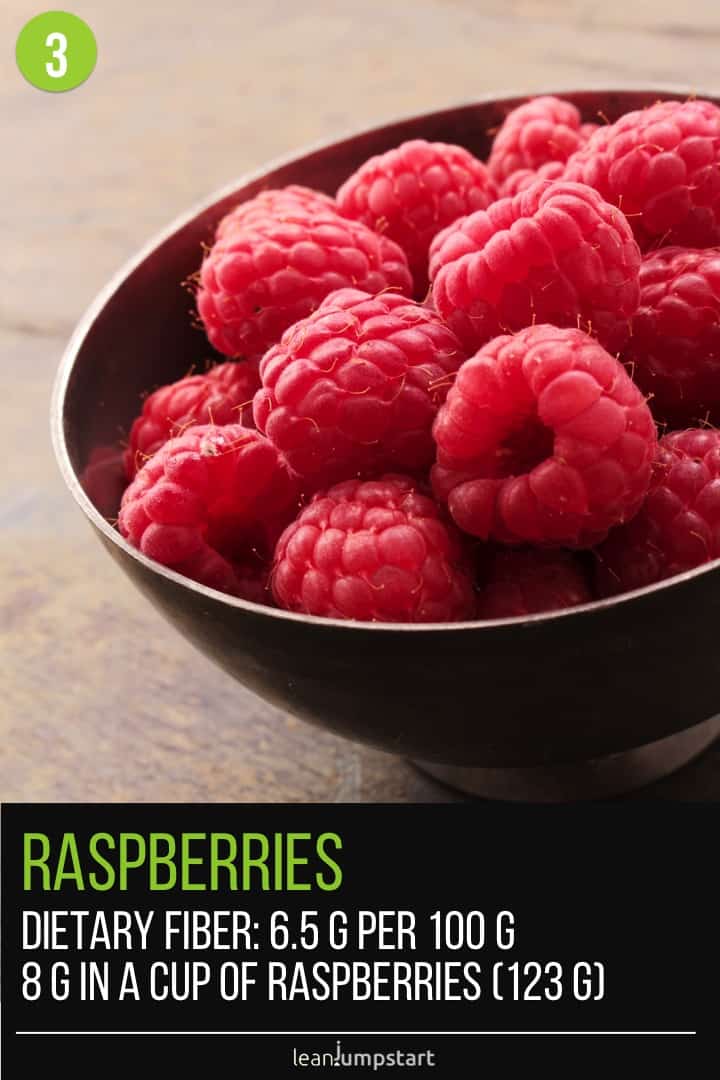
The popular little red berries are a low-calorie snack. They consist of about 85 percent water. In spite of their intense sweetness, they have relatively little sugar. With their high content of roughage, these power foods offer an easy way to stimulate digestion.
But that’s not all. Raspberries have a lot of B-group vitamins and vitamin C. They also contain the minerals potassium, calcium, magnesium, manganese and iron. Few healthy snacks are able to provide us with a greater diversity of anti-inflammatory and antioxidant phytonutrients. Besides of snacking I love to eat them in my breakfast muesli with some oats, chia seeds, and plant milk. Or how about a mouth-watering chocolate raspberry cake? Yummy!
Fiber content: 6.5 g per 100 g (3), or 8 g in a cup of organic raspberries (123 g).
4. Blackberries, raw (5.3%)

These blue-black berries were in ancient times considered as a herbal remedy. Thanks to the presence of many vitamins and nutrients, blackberries strengthen the immune system.
Compared to other berries, blackberries have the highest content of the provitamin A. The body converts this substance into vitamin A, which, among others, is important for your eye health.
Fiber content: 5.3 g per 100 g (4), or 7.6 g in a cup of blackberries (144 g).
5. Pear, raw with skin (3.1%)
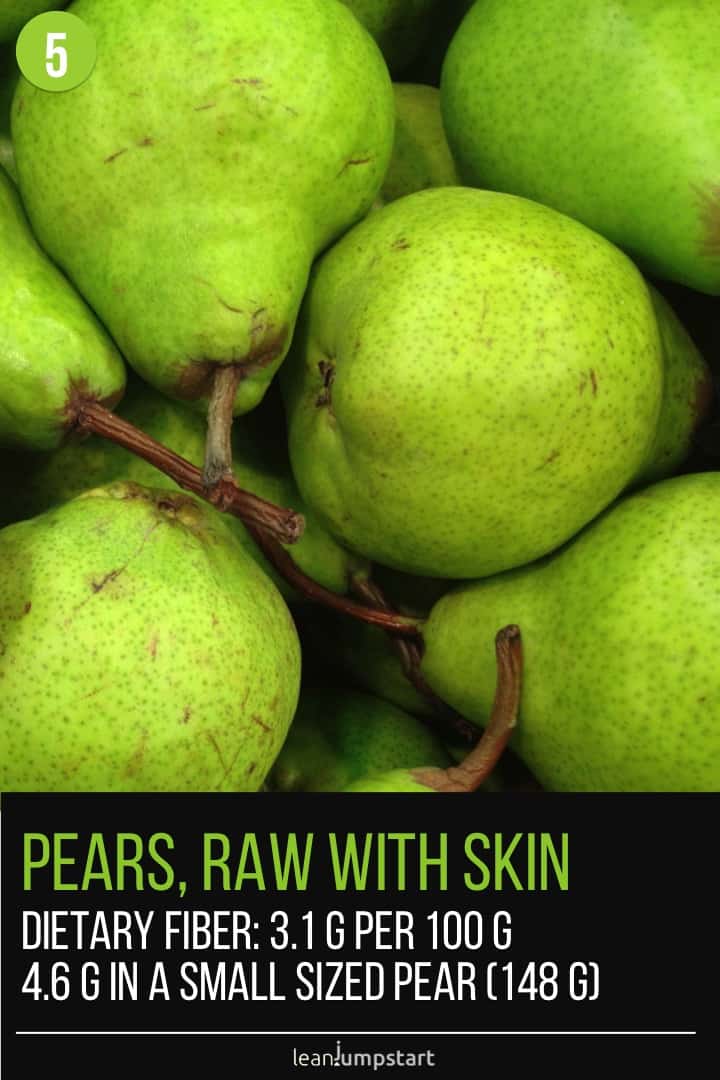
These fall fruits are readily available all year at a modest cost. Pectin makes up the largest share of natural gelling agents in pears. Due to their increased sorbitol and fructose contents, they can sometimes have a laxative effect.
Pears also supply many important minerals such as iron, potassium, copper, iodine, magnesium, and zinc. Due to their significant potassium content, they have a dehydrating effect and alleviate kidney and bladder problems.
These juicy delights have less fruit acid than apples but contain just as much sugar. Pears taste particularly sweet, are kind to your teeth and are easily digestible for acid-sensitive people and babies.
Fiber content: 3.1 g per 100 g (5) or 4.6 g in a small sized pear (148 g).
6. Kiwifruit, green, raw (3.0%)
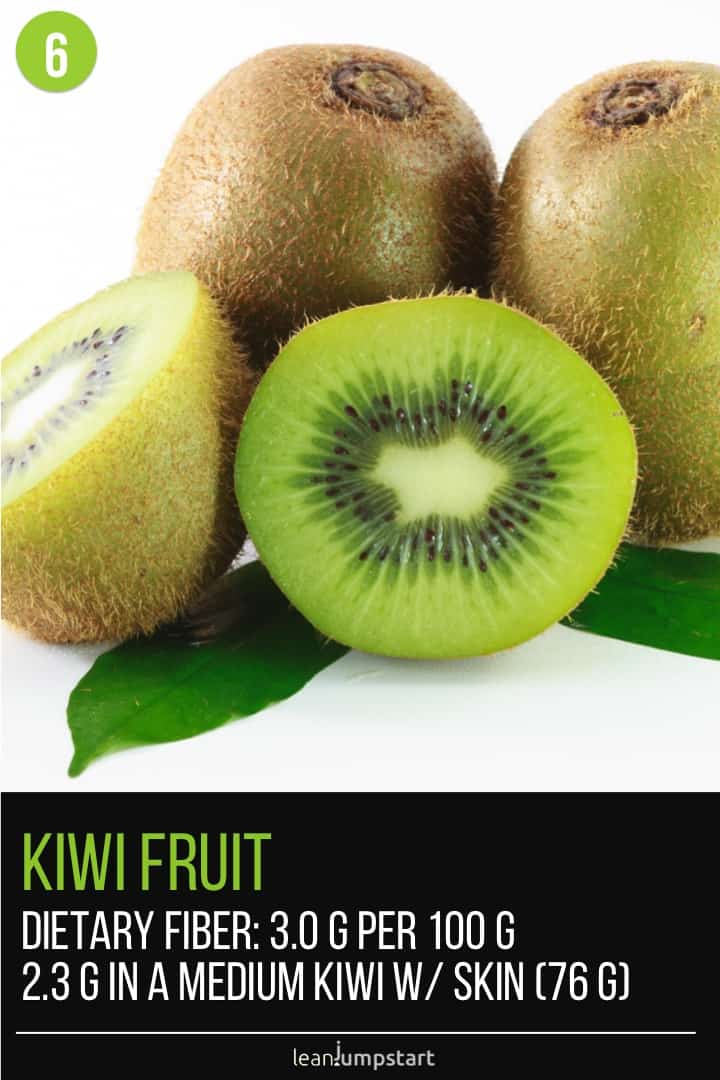
While the roughage content in kiwis is good, they have another ingredient, which is worth mentioning. Green kiwis contain a protein-splitting natural enzyme Actinidain, which occurs only in kiwis. This enzyme breaks down proteins from many foods much faster than your own digestive enzymes can on its own.
As a result, kiwis reduce bloating caused by protein-rich foods. In addition, this effect makes it easier for muscles to absorb protein. This is especially useful for those who exercise.
Fiber content: 3.0 g per 100 g (6), or 2.3 g in a medium kiwifruit without skin (76 g).
7. Bananas, raw (2.6%)
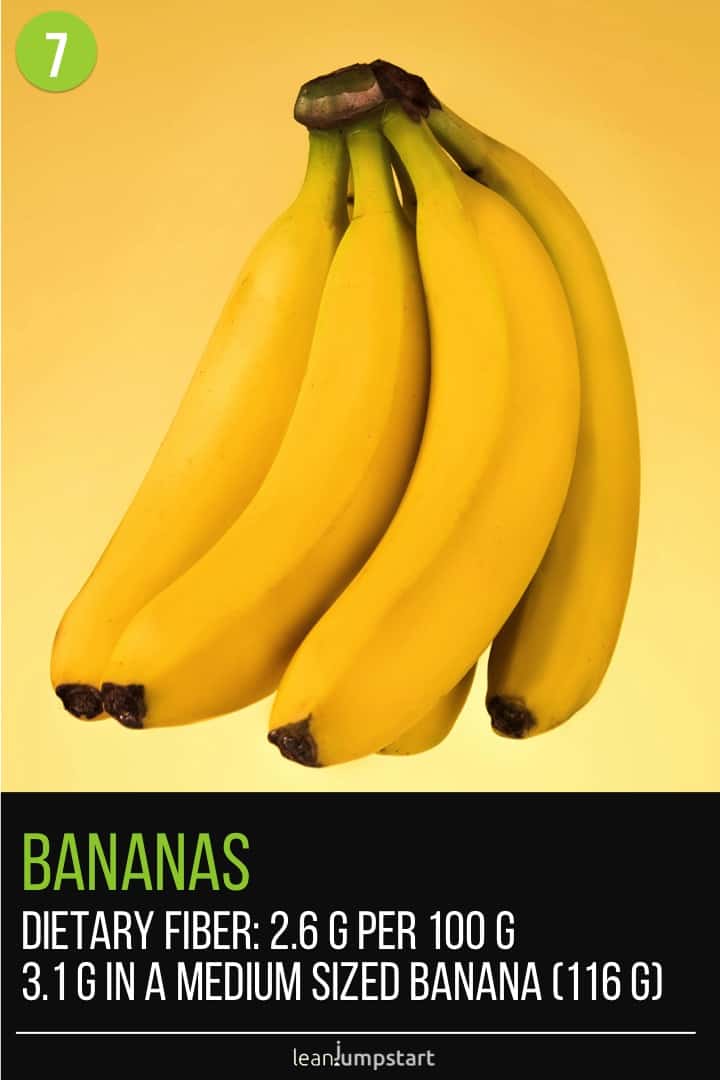
The banana is often the first fruit a baby is allowed to taste. Athletes, in particular, rely on this high-energy food. There are reasons why bananas are unique among fruits. First, bananas contain a lot of fructose. This simple sugar enters the bloodstream within minutes and provides muscles and brain with an instant energy boost.
Secondly, these nutrient-dense snacks also provide the body with a sustained supply of energy. That’s because 20 percent of the yellow fruit consists of long-chain carbohydrates. In consequence, bananas do not only provide a fast energy boost, but also a lasting one.
Most of the banana fiber content is prebiotic
Do bananas have fiber? This is a question that people often ask. The amounts of fiber in a banana is not only significant but in combination with resistant starch (a fermentable insoluble fiber), also very noteworthy.
The soluble fibers “pectin” and “oligofructose” (short-chain inulin) in banana, together with the resistant starch, belong to the most important prebiotics.
These compounds in food contribute to a healthy intestinal flora. Multiple studies show that prebiotic foods can favorably change the bacterial mix in the lower intestine.
Prebiotics serves as a food source for the microorganisms in the colon (intestinal flora) and is fermented by them. This produces short-chain fatty acids that ensure, among other things, that the gut microbiome achieves a healthy pH value.
But that’s not all!
Since the resistant starch increases stool weight, especially green bananas can counteract constipation. And …eating green bananas can also help to treat diarrhea. The reason: Contained pectin protects the intestinal mucosa and binds bacterial toxins.
Checkout my simple frozen banana ice-cream!
Fiber content: 2.6 g per 100 g (7), or 3.1 g in a medium banana (116 g).
8. Apple, raw with skin (2.4%)
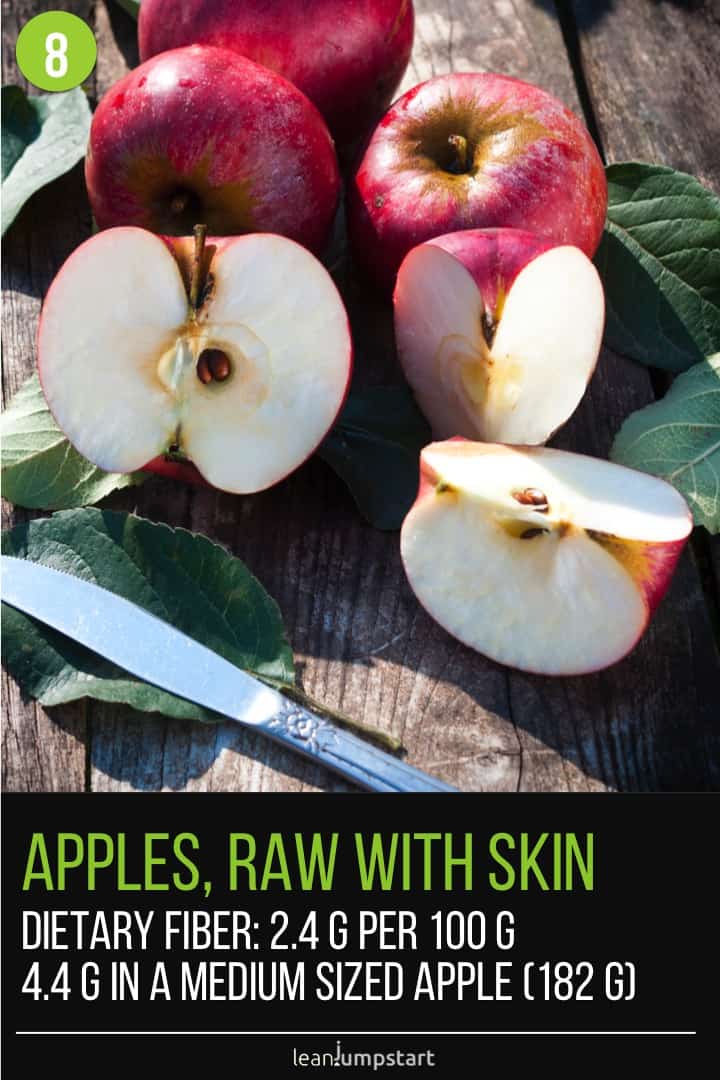
“An apple a day keeps the doctor away” – this old proverb is more than true. Apples are among the healthiest, most satisfying and tastiest fruits you can eat. They are particularly rich sources of the natural gelling agent “pectin”. In addition, the divine fruit contains over 30 vitamins and trace elements.
This makes the apple a great snack between meals or a perfect addition to your breakfast muesli. More than two-thirds of the vitamins are in the skin and directly underneath. Do not peel these vitamin bombs before eating. For this reason, I recommend buying organic apples.
Fiber content: 2.4 g per 100 g (8) or 4.4 g in a medium-sized apple.
9. Blueberries, raw (2.4%)
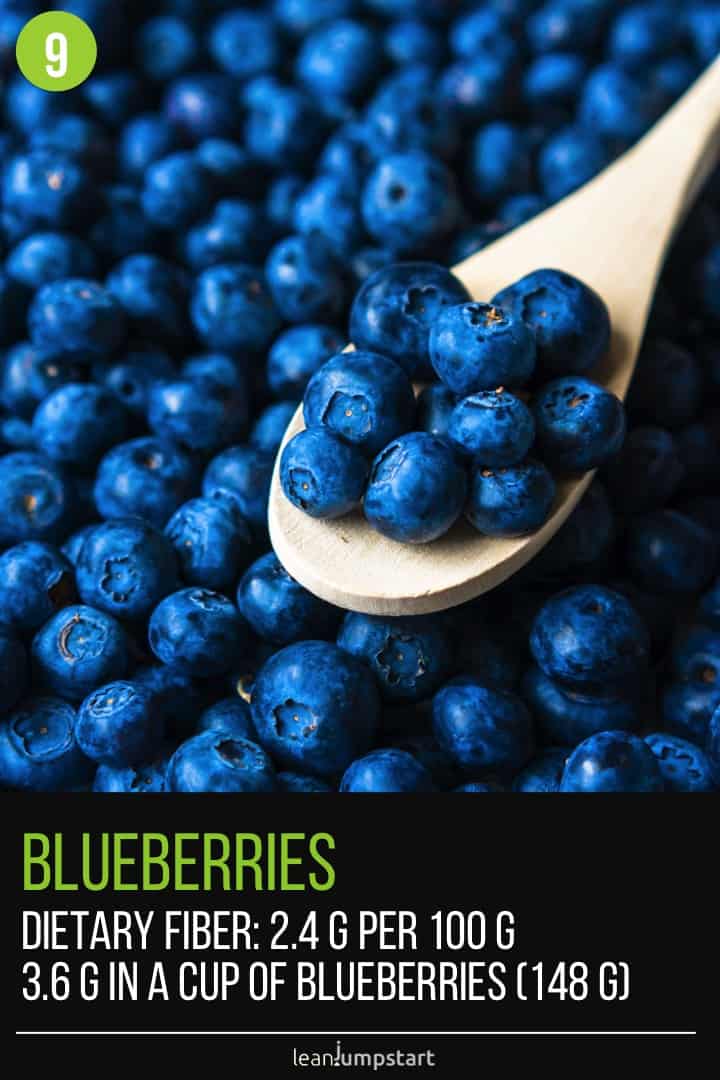
Wild blueberry bushes cover the soil of entire forests. In addition to pollination by animals, these berries reproduce underground and vegetative. That’s the reason why the heather plants of the species “Vaccinium myrtillus” are considered almost immortal.
The nutritional value and health benefits of blueberries are hard to beat. The American natives already admired the highly nutritious plant as an herbal remedy. The positive effect of eating blueberries is mainly based on secondary plant compounds such as polyphenols.
These antioxidants stop reactive molecules, which damage cells and participate in aging processes as well as inflammatory processes.
In addition to secondary compounds, blueberries also contain a lot of primary plant compounds – including iron, potassium, vitamin C, folic acid and zinc.
While dried blueberries can cure diarrhea as a household remedy, the fresh berries have a rather laxative effect.
Fiber content: 2.4 g per 100 g (9) or 3.6 g in a cup of blueberries (148 g).
10. Strawberries, raw (2.0%)
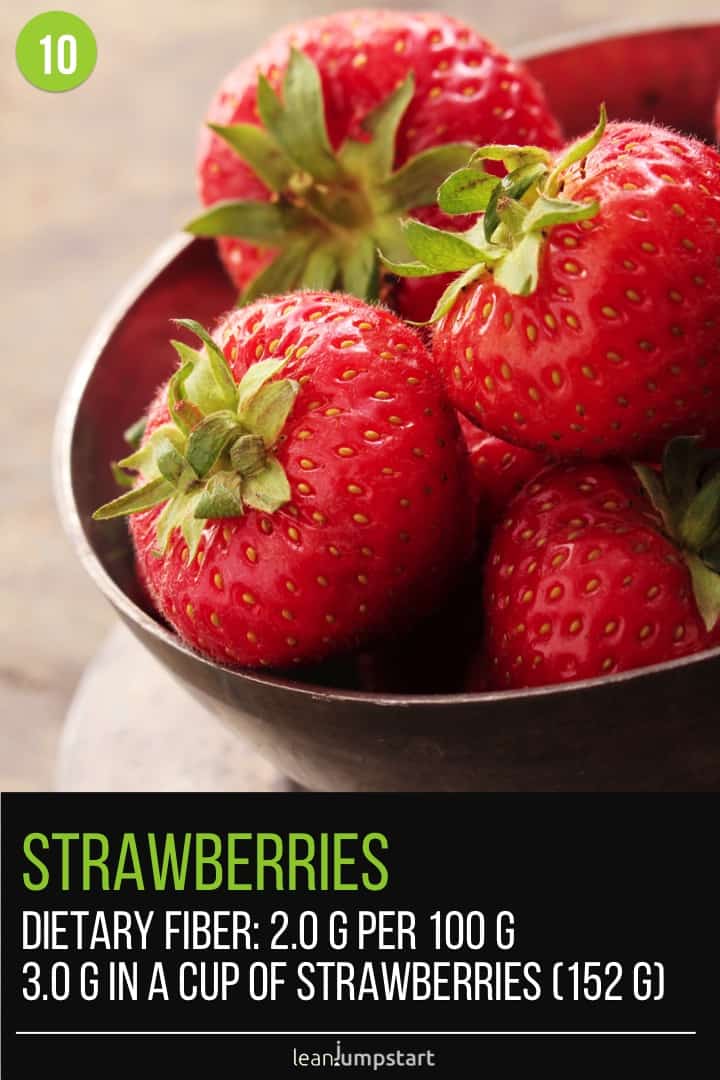
The amount of roughage in strawberries might not be impressive, but given the fact that they are very low in calories, you can eat more of them. Just do the math…With 200 grams of strawberries, you still get more bulk and almost the same calories than eating 100 grams of pears or kiwi.
The soluble natural gelling agent “pectin” and the insoluble “cellulose” keep your bowels moving. The aromatic strawberries are also rich in vitamins, especially in vitamin C. Did you know that their vitamin C content is even higher than that of lemons and oranges.
Fiber content: 2.0 g per 100 g (10), or 3.0 g in one cup of strawberry halves (152 g).
Top 26 fiber-rich fruits + dried snacks
Find in the following a table of the Top 26 fiber-rich fruits. I’ve included also dried snacks, like e.g. prunes, dried figs, and dried apples. These healthy fiber snacks are all ranking at the top spots. If you are trying to lose weight, you should eat them only sparingly, as they have a high calorie and sugar content.
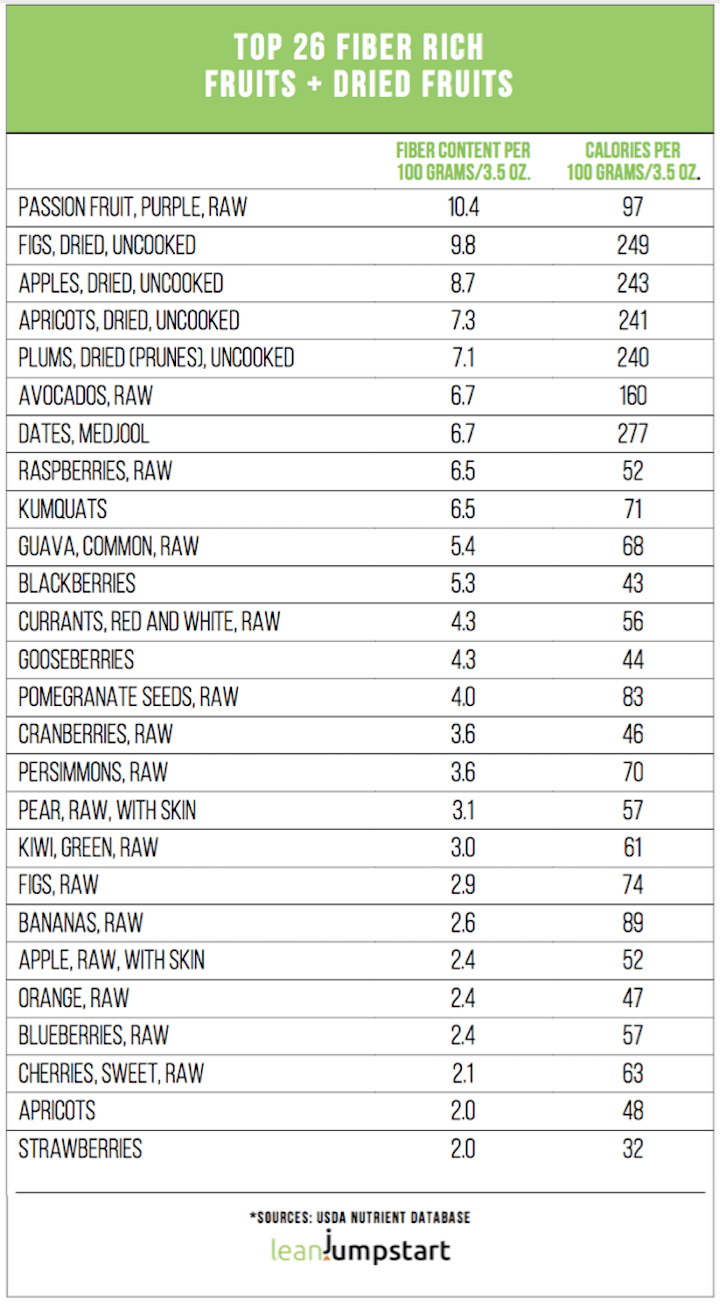
Power Berries
With an average dietary fiber content of around 5 percent (raspberries, blackberries), these superfoods are one of the best sources of these desirable substances. Also, when it comes to immune protection, only a few other fruits can hold a candle to them.
Apart from lots of vitamin C, folic acid and potassium, berries contain a maximum amount of secondary plant compounds. These antioxidants can protect our cells from free radicals, infections, and inflammations.
As berries are in season only for a short period of time, frozen raspberries, blueberries or blackberries offer a convenient way to pimp up your muesli or smoothie.
Click through to get 5 smart tips for a high fiber breakfast!
Easy to eat on the go fruits
Some easy-to-eat–on-the-go fruits include apples, pears, bananas or citrus fruits like clementines. In this category, you’ll find foods with higher amounts of natural gelling agents, the main form being pectin.
Soluble fiber is not only beneficial for your gut but also for your overall health. It lowers your risk of heart disease by reducing “bad” LDL cholesterol and supporting you balance your blood sugar levels.
Overall apple, pears or bananas are good sources of fiber. They do not contain as much roughage as berries, but these vegan snacks can easily be taken to the office or school. Furthermore, they are available at any time of the year.
Tropical fruits with natural digestive enzymes
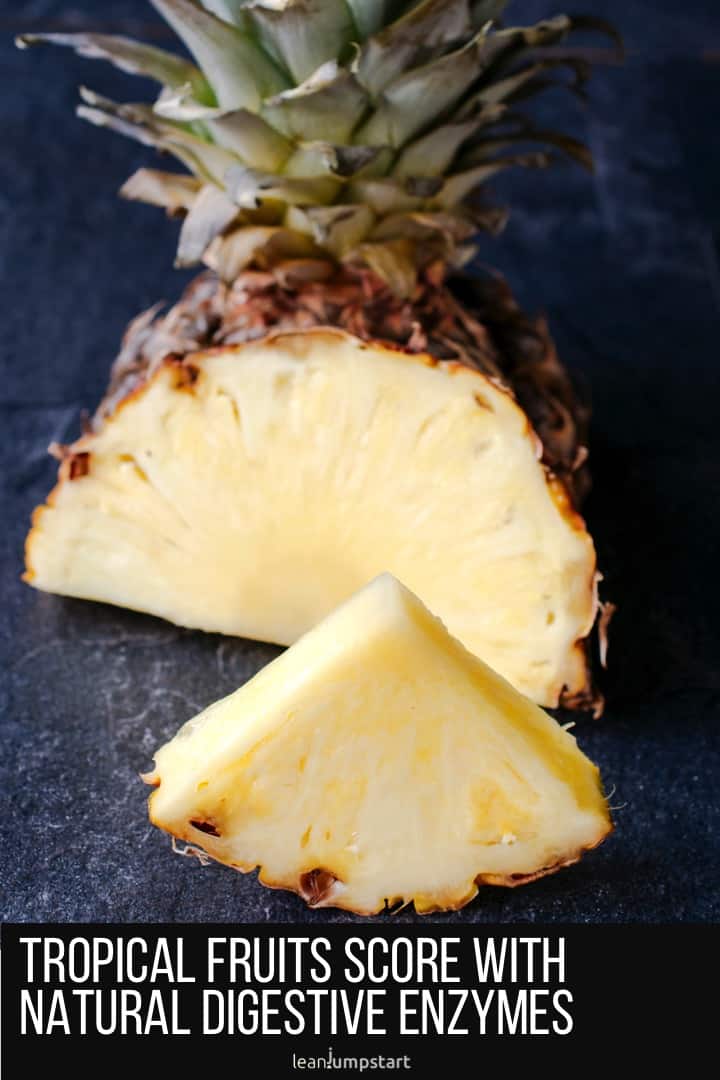
I’ve already mentioned, that the passion fruit is the winner and leading the ranking list of fruits with fiber. But also kumquats and guava are high in this precious nutrient.
You won’t find however pineapple, mango or papaya on the list of high fiber foods. Still, you should take them into your account as snacking options, if weight loss is your goal. Although they didn’t make it on the list, these exotic fruits provide important natural digestive enzymes. Did you know that pineapples are natural laxatives? A slice before each meal prevents constipation effectively.
How much fiber should you have a day?
Eating a lot of fruit and vegetables means that you don’t have to worry about consuming too little fibrous foods. The Institute of Medicine recommends:
- at least 21 to 25 grams of fiber a day for women and
- at least 30 to 38 grams a day for men
How many grams of fiber you should eat per day, depends on your history of roughage consumption and your personal goals.
If you want to lose weight, then a roughage diet like the whole food plant-based diet can be highly effective. With such an eating style the fiber intake can be more than double as high than the recommended daily amount.
For best heart disease and stroke protection, Dr. Michael Greger from nutritionfacts.org suggests consuming in total even over 70 grams of fiber a day.
Top 2 disadvantages of snacking too many fruits
An old Buddha quote says, “There is no shadow without light and no light without shadow.”
Eating too many vitamin bombs can cause also a few side effects.
- For some people, the acid in fruit can cause a problem. Fruit acid is very aggressive and can also attack the tooth enamel. In addition, if you are prone to flatulence, you should never eat fruit with the main course or as a dessert. The combination of starch and fruit acid can lead to bloating. For this reason, eat the fruit separately or as an appetizer.
- Fructose is the second ingredient in fruits you should be aware of. Compared to vegetables, fructose increases the number of calories. But fructose is not only a well-known fattening factor (think of fruit juices), in some people it can also cause food intolerances.
Bottom line
As an easy to eat source of nutrients, fruits are an essential part of a high fiber diet. If for any reasons you can’t eat at least 2 portions of fruits per day, consider vegetables like e.g. sweet potatoes as a great alternative. Veggies offer a huge selection of nutrient-dense low carb foods. For some inspiration check out my top 30 list of high fiber vegetables.

I’ll take any fruit I can get, and I love it that it all has fiber! This is a nice reminder of fruits I tend to forget about, like passionfruit. Thanks for the reminder 🙂
Your re very welcome Traci! I was in the same boat like you regarding passion fruits. Now they are my little produce super stars and we eat them on a regular basis.
I love your list of great options, hummus is my favorite snack, and all the fruit are always welcomed in my household. We eat a lot of fresh produce every day specially avocado
Your snacking habits are wonderful, Adriana. You automatically include many highly fibrous foods without thinking about it. By the way, I’m also a big fan of hummus and avocados:)
I’m crunching on an apple right now! This is a great list — so much information. I can’t believe avocado is number two. That’s not something that comes to my mind when I think of high fiber foods.
I hope you’ve found an apple snack in your home…In my region we’ve had this year a huge apple harvest and are still enjoying daily a great variety of them. Yes avocados were a big surprise for me too, given the fact that the “pulp” doesn’t look fibrous at all.
Great list and so useful! I’m getting ready to dive back into a low carb diet per doctor’s orders and know that finding enough fiber can be tough – happy to see some fruits I can eat on this list!
Hey Lauren, I’m happy that my list could inspire you to find enough fiber rich produce you can eat. All the best and enjoy!
This is such a handy reference list! I love them all and eat them as much as I can!
Thank you Bet. I love your approach as I can very much relate to it:)
We love all the fruits on this list! So glad they are so good for us.
We too, isn’t it great to have even more reasonable arguments to snack those yummy fruits?
Yay! More reasons to eat avocados…lol! 🙂 I love most of these fruits on the list, and can’t wait to stock up on them! Thanks for all this great information!
Hey Sherri, you are very welcome. Yes, for me the same – no grocery shopping without grabbing some avocados.
Wow! Great article! Very informative with several that I didn’t know.
Thank you Jennifer, I’m glad that you’ve found my article informative and that you could learn something new.
I was surprised by a couple of the fruits. I had no idea avocado was at the top of the list. Great information.
Thank you Kelly, yes avocados were a big surprise for me too…and also passion fruits. Gladly I love both:)